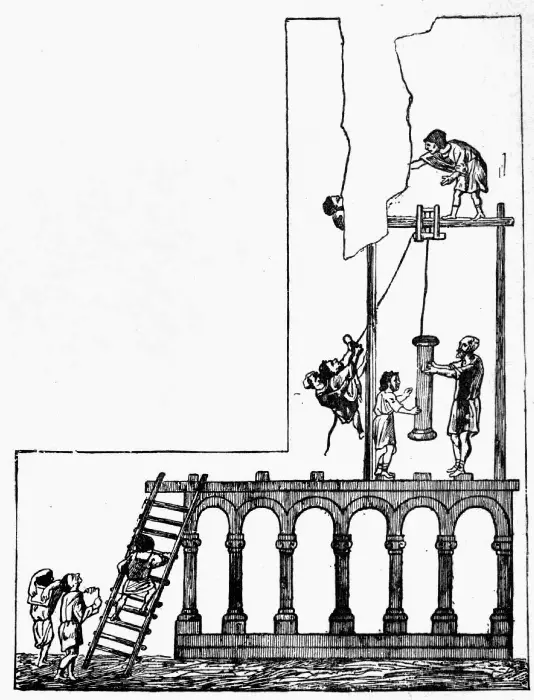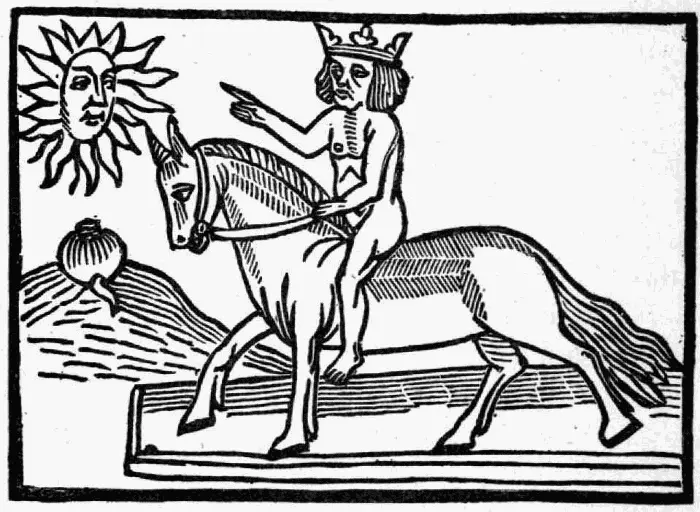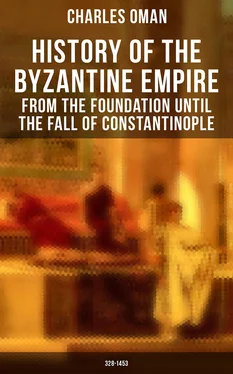Linked to the Senate House by a colonnade, lay on the north the Palace of the Patriarch, as the Bishop of Byzantium was ere long to be called, when raised to the same status as his brethren of Antioch and Alexandria. A fine building in itself, with a spacious hall of audience and a garden, the patriarchal dwelling was yet completely overshadowed by the imperial palace which rose behind it. And so it was with the patriarch himself: he lived too near his royal master to be able to gain any independent authority. Physically and morally alike he was too much overlooked by his august neighbour, and never found the least opportunity of setting up an independent spiritual authority over against the civil government, or of founding an imperium in imperio like the Bishop of Rome.
 The Atmeidan Hippodrome And St. Sophia.
The Atmeidan Hippodrome And St. Sophia.
All along the western side of the Augustaeum, facing the three buildings which we have already described, lay an edifice which played a very prominent part in the public life of Constantinople. This was the great Hippodrome, a splendid circus 640 cubits long and 160 broad, in which were renewed the games that Old Rome had known so well. The whole system the chariot-races between the teams that represented the “factions” of the Circus was reproduced at Byzantium with an energy that even surpassed the devotion of the Romans to horse racing. From the first foundation of the city the rivalry of the “Blues” and the “Greens” was one of the most striking features of the life of the place. It was carried far beyond the circus, and spread into all branches of life. We often hear of the “Green” faction identifying itself with Arianism, or of the “Blue” supporting a pretender to the throne. Not merely men of sporting interests, but persons of all ranks and professions, chose their colour and backed their faction. The system was a positive danger to the public peace, and constantly led to riots, culminating in the great sedition of a.d. 523, which we shall presently have to describe at length. In the Hippodrome the “Greens” always entered by the north-eastern gate, and sat on the east side; the “Blues” approached by the north-western gate and stretched along the western side. The emperor's box, called the Kathisma, occupied the whole of the short northern side, and contained many hundreds of seats for the imperial retinue. The great central throne of the Kathisma was the place in which the monarch showed himself most frequently to his subjects, and around it many strange scenes were enacted. It was on this throne that the rebel Hypatius was crowned emperor by the mob, with his own wife's necklace for an impromptu diadem. Here also, two centuries later, the Emperor Justinian II. sat in state after his reconquest of Constantinople, with his rivals, Leontius and Apsimarus, bound beneath his footstool, while the populace chanted, in allusion to the names of the vanquished princes, the verse, “Thou shalt trample on the Lion and the Asp.”
Down the centre of the Hippodrome ran the “spina,” or division wall, which every circus showed; it was ornamented with three most curious monuments, whose strange juxtaposition seemed almost to typify the heterogeneous materials from which the new city was built up. The first and oldest was an obelisk brought from Egypt, and covered with the usual hieroglyphic inscriptions; the second was the most notable, though one of the least beautiful, of the antiquities of Constantinople: it was the three-headed brazen serpent which Pausanias and the victorious Greeks had dedicated at Delphi in 479 b.c., after they had destroyed the Persian army at Platæa. The golden tripod, which was supported by the heads of the serpents, had long been wanting: the sacrilegious Phocians had stolen it six centuries before; but the dedicatory inscriptions engraved on the coils of the pedestal survived then and survive now to delight the archæologist. The third monument on the “spina” was a square bronze column of more modern work, contrasting strangely with the venerable antiquity of its neighbours. By some freak of chance all three monuments have remained till our own day: the vast walls of the Hippodrome have crumbled away, but its central decorations still stand erect in the midst of an open space which the Turks call the Atmeidan, or place of horses, in dim memory of its ancient use.
Along the outer eastern wall of the Hippodrome on the western edge of the Augustaeum, stood a range of small chapels and statues, the most important landmark among them being the Milion or central milestone of the empire, which we have already described. The statues, few at first, were increased by later emperors, till they extended along the whole length of the forum. Constantine's own contribution to the collection was a tall porphyry column surmounted by a bronze image which had once been the tutelary Apollo of the city of Hierapolis, but was turned into a representation of the emperor by the easy method of knocking off its head and substituting the imperial features. It was exactly the reverse of a change which can be seen at Rome, where the popes have removed the head of the Emperor Aurelius, and turned him into St. Peter, on the column in the Corso.
 Building A Palace (from a Byzantine MS.)
Building A Palace (from a Byzantine MS.)
North of the Hippodrome stood the great church which Constantine erected for his Christian subjects, and dedicated to the Divine Wisdom ( Hagia Sophia ). It was not the famous domed edifice which now bears that name, but an earlier and humbler building, probably of the Basilica-shape then usual. Burnt down once in the fifth and once in the sixth centuries, it has left no trace of its original character. From the west door of St. Sophia a wooden gallery, supported on arches, crossed the square, and finally ended at the “Royal Gate” of the palace. By this the emperor would betake himself to divine service without having to cross the street of the Chalcoprateia (brass market), which lay opposite to St. Sophia. The general effect of the gallery must have been somewhat like that of the curious passage perched aloft on arches which connects the Pitti and Uffizi palaces at Florence.
The edifices which we have described formed the heart of Constantinople. Between the Palace, the Hippodrome, and the Cathedral most of the important events in the history of the city took place. But to north and west the city extended for miles, and everywhere there were buildings of note, though no other cluster could vie with that round the Augustaeum. The Church of the Holy Apostles, which Constantine destined as the burying-place of his family, was the second among the ecclesiastical edifices of the town. Of the outlying civil buildings, the public granaries along the quays, the Golden Gate, by which the great road from the west entered the walls, and the palace of the praetorian praefect, who acted as governor of the city, must all have been well worthy of notice. A statue of Constantine on horseback, which stood by the last-named edifice, was one of the chief shows of Constantinople down to the end of the Middle Ages, and some curious legends gathered around it.
 Fifteenth-Century Drawing Of The Equestrian Statue Of Constantine.
Fifteenth-Century Drawing Of The Equestrian Statue Of Constantine.
It was in a.d. 328 or 329—the exact date is not easily to be fixed—that Constantine had definitely chosen Byzantium for his capital, and drawn out the plan for its development. As early as May 11, 330, the buildings were so far advanced that he was able to hold the festival which celebrated its consecration. Christian bishops blessed the partially completed palace, and held the first service in St. Sophia; for Constantine, though still unbaptized himself, had determined that the new city should be Christian from the first. Of paganism there was no trace in it, save a few of the old temples of the Byzantines, spared when the older streets were levelled to clear the ground for the palace and adjoining buildings. The statues of the gods which adorned the Baths and Senate House stood there as works of art, not as objects of worship.
Читать дальше

 The Atmeidan Hippodrome And St. Sophia.
The Atmeidan Hippodrome And St. Sophia. Building A Palace (from a Byzantine MS.)
Building A Palace (from a Byzantine MS.) Fifteenth-Century Drawing Of The Equestrian Statue Of Constantine.
Fifteenth-Century Drawing Of The Equestrian Statue Of Constantine.










